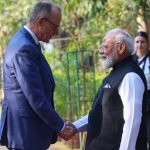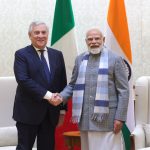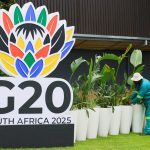 It may be a pure coincidence, but it’s a serendipity laden with enormous symbolic significance. Exactly six months after taking charge of the world’s largest democracy and pulling off a diplomatic masterstroke by inviting leaders of all South Asian countries for his swearing-in ceremony in New Delhi, Prime Minister Narendra Modi will be in Kathmandu for the 18th SAARC summit, signalling the pre-eminence of the ‘neighbourhood first’ template in his evolving foreign policy.
It may be a pure coincidence, but it’s a serendipity laden with enormous symbolic significance. Exactly six months after taking charge of the world’s largest democracy and pulling off a diplomatic masterstroke by inviting leaders of all South Asian countries for his swearing-in ceremony in New Delhi, Prime Minister Narendra Modi will be in Kathmandu for the 18th SAARC summit, signalling the pre-eminence of the ‘neighbourhood first’ template in his evolving foreign policy.
The focus on South Asia was visible from Day 1 of the Modi government and was reinforced by the prime minister’s travels to Bhutan and Nepal and External Affairs Minister Sushma Swaraj’s trips to Dhaka, Thimphu, Male and Kathmandu. It’s also fitting that Mr Modi returns to a neighbouring country to galvanise India’s South Asia diplomacy and spur the dream of an economically and culturally integrated region after engaging dozens of world leaders and attending a slew of big-ticket multilateral summits, for the destinies of the countries in the region are intimately intertwined.
Interlinked Dreams
Intertwined Destinies, Interlinked Dreams – expressions like these may appear ornate clichés for sceptics, but in reality it would be an understatement to underscore the enormous stakes each country has in fructifying immense potential of the region. India, the largest economy and the most populous country in the region, is an idealist as well as a realist in its ongoing efforts to revitalise the SAARC as the preeminent forum of regional cooperation and integration. For the India Story can’t be delinked from the state of South Asia, its choices and its conflicts and its surging hopes and aspirations.
Why South Asia Matters
Eight nations, vibrant and emerging democracies, growing economies, and home to 1.7 billion people and major religions of the world, South Asia has all the makings of a regional dynamo itching for its place under the global sun. Twenty-nine years after its founding and in the run-up to the 30th anniversary in 2015, it’s time for SAARC to bridge the gap between grand-sounding declarations and concrete action that can make South Asia a potent and effective player in the region and the world at large.
However, SAARC has been unfairly derided by sceptics as all talk and no action grouping; this critique is misplaced as SAARC may have miles to go achieve the required traction, but in its nearly three-decade journey, it has taken some important steps to cement the architecture of regional cooperation like the setting up of a South Asian University, SAARC Development Fund, a SAARC Food Bank to supplement national efforts in times of crises, and SAARC Disaster Management Centre to bail out each other in case of calamities and natural disasters. These are all laudable steps, and only underlines the need to accelerate the pace of implementation of a whole range of ideas that are waiting to take off.
And this ongoing collective effort to empower the SAARC and make the South Asia narrative of opportunity resonant will be the overarching scope of the November 26-27 Kathmandu summit –- the agenda which India wishes to proactively partner and bring it to fruition.
Regional Economic Integration
 Imparting a renewed energy and momentum to regional economic integration will top the agenda at the Kathmandu summit, which is appositely themed:
Imparting a renewed energy and momentum to regional economic integration will top the agenda at the Kathmandu summit, which is appositely themed:
“Deeper Integration for Peace, Progress and Prosperity.” The agreement on South Asian Free Trade Area (SAFTA) has led to a scaling up of intra-regional exports to about US$ 22 billion in 2013 from US$ 10 billion in 2006, but experts say this is just the tip of the iceberg. The best is yet to come, and India is expected to proactively join efforts with other countries for actualising the vision of a South Asia Economic Union. The economic union envisages greater trade liberalisation, the development of cross-border trade infrastructure and the removal of non-tariff barriers, which is hindering the free movement of goods and services in the region. With the Modi government looking to make India a manufacturing powerhouse, Prime Minister Modi is expected to push for creating new cross-border production networks and joint manufacturing projects. India should also be pushing for proactive implementation of the SAARC agreement on services as the long-range goal of creating a seamless economic space in the region can only be achieved by free movement of not just goods, but through the liberalisation of services and the free movement of professionals.
Intensifying energy cooperation will be another key priority. In this context, the SAARC summit is expected to seal a pact on energy-sharing, a defining agreement that could pave the way for opening new pathways of economic cooperation among countries of the region.
Only Connect
Connectivity is the reigning theme of the Kathmandu summit. And India’s focus, too, will be on weaving the region together in a web of rail, road and air links. One can expect SAARC countries to sign a pact for the regulation of passenger and cargo vehicular traffic and finalise modalities for stepping up trans-regional rail networks. The wish list of connectivity projects is a long one, and there are many ideas on the table, which includes, among others, a container service that connects Bangladesh and Nepal to India through the India-Pakistan Peshawar route.
Cultural Synergies
Connectivity can’t be just physical; in the end, it’s forging connections of mind and heart that matters. India is, therefore, expected to unveil new initiatives and highlight the need for promoting and deepening people-to-people, educational and cultural linkages.
Harnessing cultural and spiritual energies of the region will complement the larger project of regional integration. South Asia is the cradle of four important religions of the world – Hinduism, Buddhism, Sikhism and Jainism – and its multicultural mosaic includes nearly half a billion Muslims who live across countries in the region. Some of Sikhism’s holiest shrines are in Pakistan. Except for Lumbini in Nepal, the birthplace of Lord Buddha, Buddhism’s most important shrines are located in India, and Buddhism links India, Sri Lanka, Nepal and Bhutan.
Besides religion, one can see a literary alchemy binding the region. Nobel-winning sage-poet Rabindranath Tagore is equally popular in India and Bangladesh. Couplets penned by Urdu poets like Mirza Ghalib and Iqbal are recited with equal fervour in both India and Pakistan, and across the region.
Moving into Higher Orbit
 With such a confluence of literary, cultural and religious affinities, and reinforced by a common impulse for regional economic integration and development, it’s clearly time for South Asia. In an imaginative initiative, Prime Minister Modi has called for jointly developing a SAARC satellite that could become a powerful symbol of regional solidarity and a realistic vehicle of providing the much-needed data for averting natural disasters and meteorological data to optimise agriculture potential of individual economies and the region. Initiatives like these show that the SAARC grouping, if it wants to, is ready to move into a different orbit, literally as well as metaphorically. It’s time to raise the sights, dream big and prove that even the sky is not the limit for regional integration. Leaders should seize this SAARC moment of a potential South Asian renaissance, and unleash collective prosperity for the 1.7 billion people of the region.
With such a confluence of literary, cultural and religious affinities, and reinforced by a common impulse for regional economic integration and development, it’s clearly time for South Asia. In an imaginative initiative, Prime Minister Modi has called for jointly developing a SAARC satellite that could become a powerful symbol of regional solidarity and a realistic vehicle of providing the much-needed data for averting natural disasters and meteorological data to optimise agriculture potential of individual economies and the region. Initiatives like these show that the SAARC grouping, if it wants to, is ready to move into a different orbit, literally as well as metaphorically. It’s time to raise the sights, dream big and prove that even the sky is not the limit for regional integration. Leaders should seize this SAARC moment of a potential South Asian renaissance, and unleash collective prosperity for the 1.7 billion people of the region.
(Manish Chand is Editor-in-Chief of India Writes Network, www.indiawrites.org, a portal and e-magazine-journal focused on international affairs and the India Story)
Author Profile

- Manish Chand is Founder and Editor-in-Chief of India Writes Network (www.indiawrites.org) and India and World, a pioneering magazine focused on international affairs. He is CEO, Centre for Global India Insights, an India-based think tank focused on global affairs.
Latest entries
 India and the WorldJanuary 13, 2026India, Germany raise the bar for defence, economic ties
India and the WorldJanuary 13, 2026India, Germany raise the bar for defence, economic ties India and the WorldDecember 12, 2025India-Italy bonding: Tajani’s visit raises the bar for business, maritime ties
India and the WorldDecember 12, 2025India-Italy bonding: Tajani’s visit raises the bar for business, maritime ties In ConversationNovember 26, 2025G20 is a Force for global Good
In ConversationNovember 26, 2025G20 is a Force for global Good articlesNovember 26, 2025Rescuing G20 from North-South divide: Ubuntu Moment
articlesNovember 26, 2025Rescuing G20 from North-South divide: Ubuntu Moment







